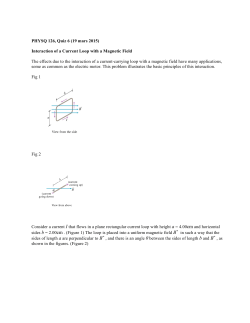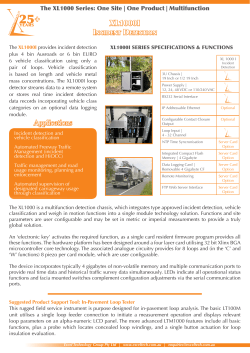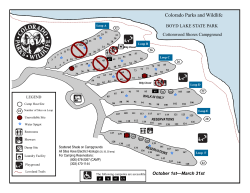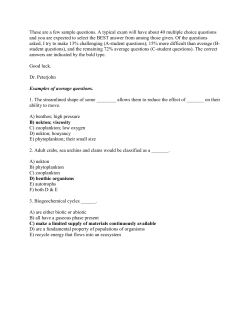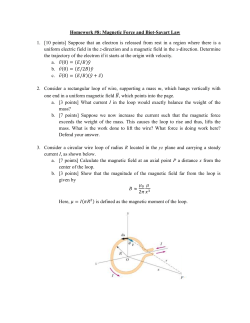
Wireless signal processing (Synchronization) - UTH e
Wireless signal processing (Synchronization) Thanasis Korakis University of Thessaly korakis@uth.gr Signal Synchronization ● Many papers on radio systems, networks and related topics usually contain the sentence “Let’s assume the system is synchronized.” ● Who did it ? ● How did they do it ? Signal Synchronization ● If the radio is not synchronized no other system can operate ○ matched filters ○ equalizer ○ detectors ○ error correcting codes ○ decryption ○ source decoding Signal Synchronization ● At the waveform level, synchronization requires the frequency and phase alignment of remote oscillators for ○ carrier acquisition and tracking ○ modulation symbol timing ○ chip alignment and hopping boundaries of spread spectrum modulation overlays Signal Synchronization ● By assuming that the system is synchronized, we skipped a challenging and most interesting part of the process. ● We have skipped the task of estimating, in a short time interval, the unknown parameters of a known signal in the presence of noise. ● We have replaced the task of processing a noisy wave shape for the easier task of processing a binary data stream with unknown errors. Simple Communication System Processing a binary data stream Processing a noisy wave shape Simple Communication System ● In the system above the input bits are subjected to a number of transformations at the modulator with matching inverse transformations at the demodulator. ● In total, the input bit stream to the modulator is converted to the radio frequency wave form at the modulator output. ● A communication system is seen through the eyes of the beholder and different eyes see different systems due to the abstraction of it’s components. Physical Layer Model Physical Layer Model ● This model emphasizes the signal conditioning and signal processing of communication waveforms exiting the modulator and entering the demodulator. ● Note that the receiver contains many more subsystems than the transmitter. ● These subsystems are participating in the signal conditioning required to demodulate the input waveform. ● These loops estimate the unknown parameters of the known input signal and invoke corrective operations. Signal Recovery ● The hardware design and development of a receiver for a particular technology is based on known information regarding the characteristics of the signal: ○ phase ○ frequency ○ modulation scheme etc Signal Recovery ● Timing recovery loop estimate and remove unknown time offsets between the receiver sampling clock and the optimal sample positions of the matched filter output series. ● Frequency recovery loop estimate and remove the unknown frequency offset between the input signal’s nominal and actual carrier frequency. ● Phase recovery loop estimate and remove unknown carrier phase offset between input signal and local oscillator. Signal Recovery ● AGC (Automatic Gain Control) loop estimate and remove the unknown channel attenuation. ● Equalizer loop estimate and remove unknown channel distortion responsible for intersymbol interference. ● SNR estimator supply important side information to the just enumerated subsystems (Timing, Frequency and Phase recovery loops). Timing Recovery Loop ● In wired systems there is no need of Timing Recovery Loop because synchronization is explicit. ● The case of transmitter and receiver sharing the same clock would be the ideal. ● This case is typically impossible in a wireless communications system. ● The receiver must know the sample frequency and where to take the samples within each symbol interval. Timing Recovery Loop ● The main purpose of the Timing Recovery Loop is to obtain symbol synchronization. ● The receiver must be able to determine the unknown time delay τ. ● This estimation is based on observations of a sampled data sequence y(n) derived from the output of a matched filter. ● The estimate can be obtained from a bank of matched filters parameterized over the unknown variable such a time delay τ. Timing Recovery Loop Correlation magnitude Timing Recovery Loop ● The outputs of the filter bank at specific symbol time are subjected to a detector and are averaged to obtain stable statistics. ● The smoothed outputs are compared and the filter with the largest output magnitude is the one matched to the signal time delay τ. ● In modern receivers, the filter bank is available to the receiver as the paths of an M-path polyphase filter. Timing Recovery Loop ● Rather than operate all the paths simultaneously, Mpath polyphase filters are operated sequentially in response to side information which guides a state machine to the peak of the correlation function. ● This side information is the slope at the output of each hypothesized filter selection. ● The system selects any filter in the bank and tests the hypothesis that this is the correct filter. Phase Recovery Loop ● In many modulators the signal formed by the shaping filter is amplitude and phase modulated in accord with the input bit mapping process. ● The amplitude and phase terms are represented in Cartesian coordinates and described as a complex base band signal. ● The quadrature components of the signal are upconverted or amplitude modulated on the quadrature components, the cosine and sine, of a radio frequency carrier. Phase Recovery Loop ● At the demodulator the process is reversed and the radio frequency carrier is down converted. ● The frequency and phase of the upconverter and the downconverter oscillators do not match in terms of manufacturing tolerances, age and temperature related drift, and Doppler offsets due to velocity vectors between platforms. ● The signal obtained at the output of the quadrature down converter is monitored and applied to a phase detector to obtain a measure of the phase misalignment. Phase Recovery Loop Phase Recovery Loop ● Phase Detector (PD) measures the difference between the phase of the local oscillator and the input carrier. ● A quadrature signal is a complex signal composed of two sinusoids at the same frequency but with a π/2 phase offset between them. ● The quadrature PD generates its error by multiplying the two signals together and taking the imaginary part of the output. ● The quadrature phase detector output is the sine of the ideal phase detector’s error. Phase Recovery Loop Frequency Recovery Loop ● If the frequency offset between the local oscillator used in the final down converter and the center frequency of the input signal is sufficiently small, the phase detector can acquire and de-spin the input signal. ● On the other hand, if the frequency offset is significantly larger than the bandwidth of the PLL loop filter the loop will not successfully acquire and de-spin the signal. ● In this event an acquisition aid must be invoked to assist the phase lock loop. Frequency Recovery Loop 1st scenario: centered 2nd scenario: shifted Frequency Recovery Loop ● The upper scenario in which the input spectrum is centered between the two band edge filters ○ the two band edge filters collect the same energy from the input spectrum and their average energy difference is zero ● The bottom scenario in which the input spectrum has shifted towards one and away from the other band edge filter ○ the two band edge filters collect different amounts of energy from the input spectrum and their energy difference is proportional to the frequency offset Frequency Recovery Loop Challenges in SDR ● SDR goal: “To dynamically adapt it’s operation to function in any frequency using any technology, based on a variety of information that it collects through signal detection” ● High challenges to implement this goal due to: ○ high hardware design complexity in order to implement multiple module chains one for each technology ○ high difficulty due to hardaware limitations for dynamically switching between the different module chains ■ time limitations ■ processing limitations References 1. Fred Harris, Let’s Assume the System Is Synchronized 2. Mervi Berner, Timing and Carrier Recovery
© Copyright 2025

